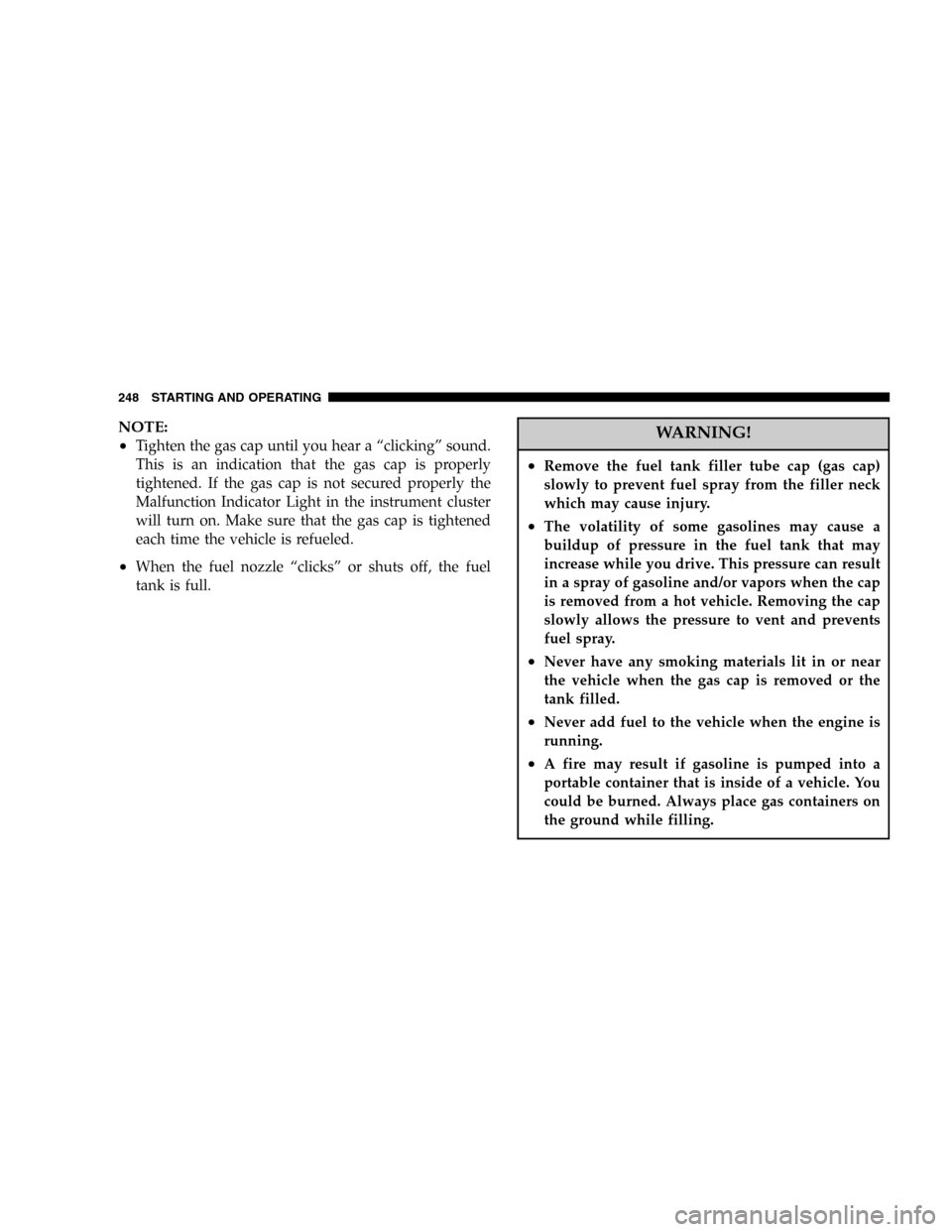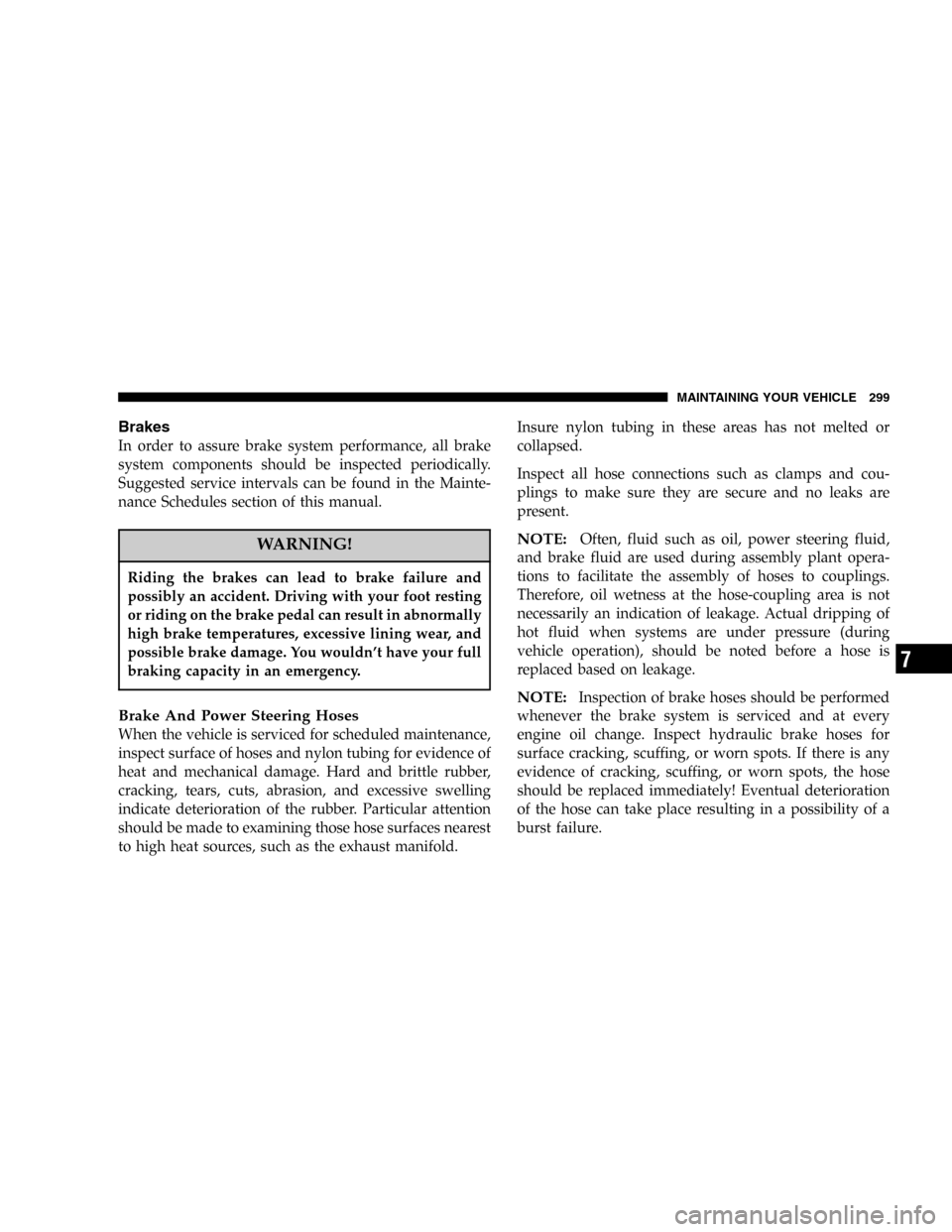ECU DODGE MAGNUM 2005 1.G Owner's Manual
[x] Cancel search | Manufacturer: DODGE, Model Year: 2005, Model line: MAGNUM, Model: DODGE MAGNUM 2005 1.GPages: 368
Page 210 of 368

A reset feature is available to allow the vehicle to be
driven to a dealer for service. To reset the transmission,
use the following procedure:
1. Stop the vehicle.
2. Move the selector lever to the PARK position.
3. Turn off the engine.
4. Wait approximately 10 seconds.
5. Restart the engine.
6. Move the shift lever to the desired range. If the
problem is no longer detected, the transmission will
return to normal operation.
NOTE:Even if the transmission can be reset, we
recommend that you visit a dealer at your earliest
possible convenience. Your dealer has diagnostic equip-
ment to determine if the problem could recur.Have the transmission checked at your authorized dealer
as soon as possible.
If the problem has been momentary, the transmission can
be reset to regain all forward gears.
Permanent Transmission Limp Home Mode
Permanent Limp Home Mode will be activated if the
transmission enters temporary Limp Home Mode three
times. Follow the reset procedure described in the previ-
ous section. In Permanent Limp Home Mode, PARK(P),
REVERSE(R) and NEUTRAL(N) will continue to operate.
SECOND gear will operate in the DRIVE(D) shifter
position. The malfunction indicator lamp may illuminate.
210 STARTING AND OPERATING
Page 248 of 368

NOTE:
•
Tighten the gas cap until you hear a“clicking”sound.
This is an indication that the gas cap is properly
tightened. If the gas cap is not secured properly the
Malfunction Indicator Light in the instrument cluster
will turn on. Make sure that the gas cap is tightened
each time the vehicle is refueled.
•When the fuel nozzle“clicks”or shuts off, the fuel
tank is full.
WARNING!
•Remove the fuel tank filler tube cap (gas cap)
slowly to prevent fuel spray from the filler neck
which may cause injury.
•The volatility of some gasolines may cause a
buildup of pressure in the fuel tank that may
increase while you drive. This pressure can result
in a spray of gasoline and/or vapors when the cap
is removed from a hot vehicle. Removing the cap
slowly allows the pressure to vent and prevents
fuel spray.
•Never have any smoking materials lit in or near
the vehicle when the gas cap is removed or the
tank filled.
•Never add fuel to the vehicle when the engine is
running.
•A fire may result if gasoline is pumped into a
portable container that is inside of a vehicle. You
could be burned. Always place gas containers on
the ground while filling.
248 STARTING AND OPERATING
Page 250 of 368

Overloading
The load carrying components (axle, springs, tires,
wheels, etc.) of your vehicle will provide satisfactory
service as long as you do not exceed the GVWR and front
and rear GAWR.
The best way to figure out the total weight of your
vehicle is to weigh it when it is fully loaded and ready for
operation. Weigh it on a commercial scale to insure that it
is not over the GVWR.
Figure out the weight on the front and rear of the vehicle
separately. It is important that you distribute the load
evenly over the front and rear axles.
Overloading can cause potential safety hazards and
shorten useful service life. Heavier axles or suspension
components do not necessarily increase the vehicle’s
GVWR.
Loading
To load your vehicle properly, first figure out its empty
weight, axle by axle and side by side. Store heavier items
down low and be sure you distribute their weight as
evenly as possible. Stow all loose items securely beforedriving. If weighing the loaded vehicle shows that you
have exceeded either GAWR, but the total load is within
the specified GVWR, you must redistribute the weight.
Improper weight distribution can have an adverse effect
on the way your vehicle steers and handles and the way
the brakes operate.
A loaded vehicle is shown in the illustration. Note that
neither the GVWR or the GAWR capacities have been
exceeded.
250 STARTING AND OPERATING
Page 260 of 368

•Lift the access cover using the pull strap.•Remove the fastener securing the spare tire.
260 WHAT TO DO IN EMERGENCIES
Page 261 of 368

•Remove the spare tire.
•Remove the fastener securing the jack.
Spare Tire Stowage
The spare tire is stowed under an access cover under the
rear cargo floor. Follow these steps to access the spare
tire.
•Open the liftgate.
•Fold up the tri-fold floor by lifting the handle.
WHAT TO DO IN EMERGENCIES 261
6
Page 263 of 368

•Remove the fastener securing the spare tire.
Jacking and Changing a Tire
1. Block the wheel diagonally
opposite the flat tire. Passengers
should not remain in the vehicle
when the vehicle is being jacked.2. Remove the spare tire, jack and lug wrench.
3. Before raising the vehicle, use lug wrench to carefully
pry off center cap.
WHAT TO DO IN EMERGENCIES 263
6
Page 298 of 368

If an examination of your engine compartment shows no
evidence of radiator or hose leaks, the vehicle may be
safely driven. The vapor will soon dissipate.
•Do not overfill the coolant bottle.
•Check coolant freeze point in the system.
•If frequent coolant additions are required, the cooling
system should be pressure tested for leaks.
•Maintain coolant concentration at 50% ethylene glycol
antifreeze (minimum) in water for proper corrosion
protection of your engine which contains aluminum
components.
•Make sure that the radiator and coolant bottle hoses
are not kinked or obstructed.
•Keep the front of the radiator and the front of the A/C
condenser clean.
•Do not change the thermostat for summer or winter
operation. If replacement is ever necessary, install
ONLY the correct type thermostat. Other designs may
result in unsatisfactory cooling performance.
•Increasing engine speed at idle does not reduce cool-
ant temperature! Put transmission in NEUTRAL and
let engine idle at normal engine idle speed.
Hoses And Vacuum/Vapor Harnesses
Inspect surfaces of hoses and nylon tubing for evidence
of heat and mechanical damage. Hard or soft spots,
brittle rubber, cracking, tears, cuts, abrasions, and exces-
sive swelling indicate deterioration of the rubber.
Pay particular attention to those hoses nearest to high
heat sources such as the exhaust manifold. Inspect hose
routing to be sure hoses do not come in contact with any
heat source or moving component which may cause heat
damage or mechanical wear.
Insure nylon tubing in these areas has not melted or
collapsed.
Inspect all hose connections such as clamps and cou-
plings to make sure they are secure and no leaks are
present.
Components should be replaced immediately if there is
any evidence of wear or damage that could cause failure.
298 MAINTAINING YOUR VEHICLE
Page 299 of 368

Brakes
In order to assure brake system performance, all brake
system components should be inspected periodically.
Suggested service intervals can be found in the Mainte-
nance Schedules section of this manual.
WARNING!
Riding the brakes can lead to brake failure and
possibly an accident. Driving with your foot resting
or riding on the brake pedal can result in abnormally
high brake temperatures, excessive lining wear, and
possible brake damage. You wouldn’t have your full
braking capacity in an emergency.
Brake And Power Steering Hoses
When the vehicle is serviced for scheduled maintenance,
inspect surface of hoses and nylon tubing for evidence of
heat and mechanical damage. Hard and brittle rubber,
cracking, tears, cuts, abrasion, and excessive swelling
indicate deterioration of the rubber. Particular attention
should be made to examining those hose surfaces nearest
to high heat sources, such as the exhaust manifold.Insure nylon tubing in these areas has not melted or
collapsed.
Inspect all hose connections such as clamps and cou-
plings to make sure they are secure and no leaks are
present.
NOTE:Often, fluid such as oil, power steering fluid,
and brake fluid are used during assembly plant opera-
tions to facilitate the assembly of hoses to couplings.
Therefore, oil wetness at the hose-coupling area is not
necessarily an indication of leakage. Actual dripping of
hot fluid when systems are under pressure (during
vehicle operation), should be noted before a hose is
replaced based on leakage.
NOTE:Inspection of brake hoses should be performed
whenever the brake system is serviced and at every
engine oil change. Inspect hydraulic brake hoses for
surface cracking, scuffing, or worn spots. If there is any
evidence of cracking, scuffing, or worn spots, the hose
should be replaced immediately! Eventual deterioration
of the hose can take place resulting in a possibility of a
burst failure.
MAINTAINING YOUR VEHICLE 299
7
Page 318 of 368

License Lamp
1. Remove the screws securing the light to the rear fascia.
2. Remove the bulb and socket assembly and pull the
bulb from the socket.3. Replace the bulb and reinstall the bulb and socket
assembly.
4. Reattach the light to the rear fascia.
318 MAINTAINING YOUR VEHICLE
Page 350 of 368

Adding Fuel.......................... 247
Adding Washer Fluid..................97,293
Additives, Fuel........................ 245
Adjustable Pedals....................... 88
Air Conditioner Maintenance.............. 290
Air Conditioning....................... 185
Air Conditioning Filter................194,291
Air Conditioning, Operating Tips........... 195
Air Conditioning Refrigerant.............. 291
Air Conditioning System................. 185
Air Pressure, Tires...................... 229
Airbag................................ 36
Airbag Deployment....................40,41
Airbag Light....................40,47,58,135
Airbag Maintenance...................... 43
Airbag, Side........................... 42
Airbag, Window......................37,42
Alarm System.......................... 24
Alignment and Balance.................. 235
All Wheel Drive.....................235,302
Alterations/Modifications, Vehicle............ 7
Antenna, Satellite Radio.................. 180
Antifreeze Disposal..................... 297Antifreeze (Engine Coolant).........295,296,319
Anti-Lock Brake System.................. 216
Anti-Lock Warning Light................. 140
Anti-Theft Security Alarm................. 24
Appearance Care....................... 303
Auto Down Power Windows............... 28
Automatic Dimming Mirror................ 62
Automatic Door Locks..................17,18
Automatic Temperature Control............ 188
Automatic Transaxle..................... 301
Adding Fluid........................ 321
Selection Of Lubricant................. 321
Automatic Transmission............201,206,302
Adding Fluid........................ 302
Fluid and Filter Changes................ 302
Fluid Change........................ 302
Fluid Level Check..................... 301
Gear Ranges......................... 202
Torque Converter..................... 204
Automatic Transmission Limp Home Mode . . . 205
Autostick..........................208,213
Ball Joints............................ 292
350 INDEX